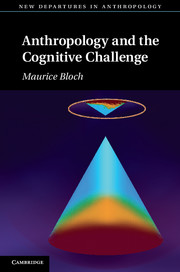89 results
9 - Monism, Dualism and Participant Observation
-
-
- Book:
- Human Nature and Social Life
- Published online:
- 14 June 2017
- Print publication:
- 15 June 2017, pp 141-149
-
- Chapter
- Export citation
CONVERTING TO CONSERVATION - Forest and Labor in Madagascar: From Colonial Concession to Global Biosphere. By Genese Marie Sodikoff. Bloomington, IN: Indiana University Press, 2012. Pp. xix + 245. $70, hardback (ISBN 978-0-253-00309-6); $25, paperback (ISBN 978-0-253-00577-9).
-
- Journal:
- The Journal of African History / Volume 56 / Issue 2 / July 2015
- Published online by Cambridge University Press:
- 12 June 2015, pp. 335-337
- Print publication:
- July 2015
-
- Article
- Export citation
5 - Time and the anthropologists
-
- Book:
- Anthropology and the Cognitive Challenge
- Published online:
- 05 August 2012
- Print publication:
- 28 June 2012, pp 79-116
-
- Chapter
- Export citation

Anthropology and the Cognitive Challenge
-
- Published online:
- 05 August 2012
- Print publication:
- 28 June 2012
4 - The nature/culture wars
-
- Book:
- Anthropology and the Cognitive Challenge
- Published online:
- 05 August 2012
- Print publication:
- 28 June 2012, pp 44-78
-
- Chapter
- Export citation
7 - What goes without saying
-
- Book:
- Anthropology and the Cognitive Challenge
- Published online:
- 05 August 2012
- Print publication:
- 28 June 2012, pp 143-185
-
- Chapter
- Export citation
References
-
- Book:
- Anthropology and the Cognitive Challenge
- Published online:
- 05 August 2012
- Print publication:
- 28 June 2012, pp 218-229
-
- Chapter
- Export citation
8 - Memory
-
- Book:
- Anthropology and the Cognitive Challenge
- Published online:
- 05 August 2012
- Print publication:
- 28 June 2012, pp 186-217
-
- Chapter
- Export citation
6 - Reconciling social science and cognitive science notions of the ‘self ’
-
- Book:
- Anthropology and the Cognitive Challenge
- Published online:
- 05 August 2012
- Print publication:
- 28 June 2012, pp 117-142
-
- Chapter
- Export citation
Contents
-
- Book:
- Anthropology and the Cognitive Challenge
- Published online:
- 05 August 2012
- Print publication:
- 28 June 2012, pp vii-vii
-
- Chapter
- Export citation
2 - Innateness and social scientists' fears
-
- Book:
- Anthropology and the Cognitive Challenge
- Published online:
- 05 August 2012
- Print publication:
- 28 June 2012, pp 14-23
-
- Chapter
- Export citation
Index
-
- Book:
- Anthropology and the Cognitive Challenge
- Published online:
- 05 August 2012
- Print publication:
- 28 June 2012, pp 230-234
-
- Chapter
- Export citation
3 - How anthropology abandoned a naturalist epistemology: a cognitive perspective on the history of anthropology
-
- Book:
- Anthropology and the Cognitive Challenge
- Published online:
- 05 August 2012
- Print publication:
- 28 June 2012, pp 24-43
-
- Chapter
- Export citation
Acknowledgements
-
- Book:
- Anthropology and the Cognitive Challenge
- Published online:
- 05 August 2012
- Print publication:
- 28 June 2012, pp viii-x
-
- Chapter
- Export citation
Frontmatter
-
- Book:
- Anthropology and the Cognitive Challenge
- Published online:
- 05 August 2012
- Print publication:
- 28 June 2012, pp i-vi
-
- Chapter
- Export citation
1 - Why anthropologists cannot avoid cognitive issues and what they gain from these
-
- Book:
- Anthropology and the Cognitive Challenge
- Published online:
- 05 August 2012
- Print publication:
- 28 June 2012, pp 1-13
-
- Chapter
- Export citation
Kinship terms are not kinship
-
- Journal:
- Behavioral and Brain Sciences / Volume 33 / Issue 5 / October 2010
- Published online by Cambridge University Press:
- 17 December 2010, p. 384
-
- Article
- Export citation
6 - Is there religion at Çatalhöyük…or are there just houses?
-
-
- Book:
- Religion in the Emergence of Civilization
- Published online:
- 05 June 2012
- Print publication:
- 30 August 2010, pp 146-162
-
- Chapter
- Export citation
Why a theory of human nature cannot be based on the distinction between universality and variability: Lessons from anthropology
-
- Journal:
- Behavioral and Brain Sciences / Volume 33 / Issue 2-3 / June 2010
- Published online by Cambridge University Press:
- 15 June 2010, pp. 83-84
-
- Article
- Export citation
Symbols, Song, Dance and Features of Articulation Is religion an extreme form of traditional authority?
-
- Journal:
- European Journal of Sociology / Archives Européennes de Sociologie / Volume 15 / Issue 1 / May 1974
- Published online by Cambridge University Press:
- 28 July 2009, pp. 54-81
-
- Article
- Export citation



